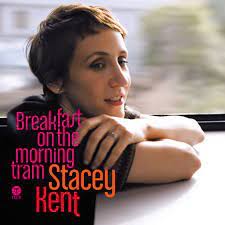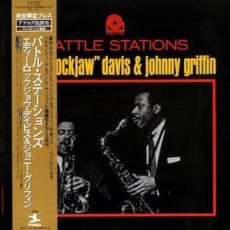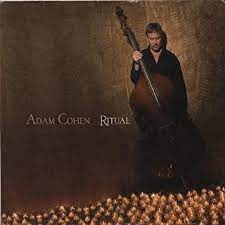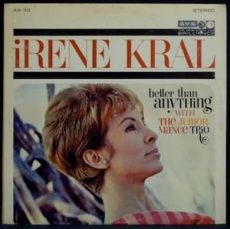
Daily Dose Of Jazz…
Tina May was born March 30, 1961 in Gloucester, England. She lived in Frampton-on-Severn when she was young and attended Stroud High School.
She has recorded twenty-five albums as a leader and three as a guest artist, of which18 albums are on the 33 Records label. She has worked with Tony Coe, Nikki Iles, Stan Sulzmann, Ray Bryant, Enrico Pieranunzi and Patrick Villanueva.
In 1989 she married jazz drummer and bandleader Clark Tracey and recorded several albums with him in the 1990s. Vocalist Tina May continues to perform, record and explore the azz idiom.
More Posts: bandleader,history,instrumental,jazz,music,vocal

Daily Dose Of Jazz…
Stacey Kent was born March 27, 1965 in South Orange, New Jersey. After graduating from Sarah Lawrence College, she crossed the pond to study music at the Guildhall School of Music and Drama in London, England where she met and married saxophonist Jim Tomlinson.
In the 1990s, she began her professional career singing at Café Bohème in London’s Soho. After two or three years, she began opening for established acts at Ronnie Scott’s Jazz Club in London. By 1995, she appeared in the film Richard III singing Come Live with Me and Be My Love. Her debut album, Close Your Eyes, was released in 1997.
In 2020, Kent released a series of singles and EPs, including “Christmas in the Rockies”, “Three Little Birds”, “Lovely Day”, “Landslide”, “I Wish I Could Go Travelling Again”, “Bonita” and “Craigie Burn” as a duet with her longtime pianist Art Hirahara. Several of these singles become part of an album released on Sept 17, 2021, called “Songs From Other Places.”
She has received several awards and honors including receiving the Chevalier dans l’Ordre des Arts et des Lettres (Order of Arts and Letters) in 2009. Grammy-nominated vocalist Stacey Kent has recorded nearly two dozen albums and continues to explore the realm of her music.
More Posts: bandleader,history,instrumental,jazz,music,vocal

Requisites
Battle Stations ~ Eddie “Lockjaw” Davis & Johnny Griffin | By Eddie Carter
It happened like this; that same night after I listened to The Happy Blues, I decided to turn up the heat with my next selection. That’s what prompted this morning’s choice from the library by tenor saxophonists, Eddie “Lockjaw” Davis and Johnny Griffin. Battle Stations (Prestige PRLP 7282/PRST 7282), hit the stores in 1963 and both horns are anchored by a smokin’ rhythm section, Norman Simmons on piano, Vic Sproles on bass, and Ben Riley on drums. My copy used in this report is the 1993 Japanese Mono reissue (Prestige VIJJ-30008 – PRLP 7282) by Victor Musical Industries.
Side One takes off at a fast clip on What’s Happening by Fletcher Henderson. The quintet speeds through the melody collectively, then Eddie erupts into an energetic opening statement. Norman steps up next with a spirited performance, then Johnny wails for a bit on the third reading. Both saxes move with considerable agility on a vigorous exchange into the quintet’s speedy ending. Abundance by Norman Connors slows the group’s pace just a few notches with a soulful melody in unison. “Lockjaw” goes first and gives a charming performance. Connors takes the reins next for an easy, flowing solo and Griff extends the mood on the finale with a satisfying statement succeeded by the ensemble’s reprise and climax.
If I Had You by Jimmy Campbell, Reginald Connelly and Ted Shapiro is up next. “Lockjaw” leads the rhythm section at a relaxing tempo on the melody and exhibits a simple beauty in the opening chorus. Norman is simply enchanting on the second reading. Johnny adds a delightful depth of emotion to the closing solo complemented by Vic and Ben’s supplement. Johnny Griffin’s 63rd Street Theme begins Side Two at mid tempo with a Latin flavor established by the rhythm section’s introduction and ensemble’s opening chorus. Davis approaches the lead solo with unhurried pacing and inspired lines. Connors packs plenty of feeling into the second presentation, then Griff is very smooth on the closing statement preceding the finale.
Pull My Coat by Richard Evans is a blues that comes to life with a brief bass introduction by Vic preceding the ensemble’s collective theme. Eddie opens anchored by just bass and drums, segueing into a splendid performance with full rhythm. Norman moves leisurely into the second solo with some down-home cooking. Johnny serves some succulent soul food on the closer. The quintet ends the set with a fun original by Babs Gonzales and James Moody, Hey Jim! Connors and the rhythm section opens with a happy introduction that grows into the ensemble’s unison theme. “Lockjaw” gives the first solo some swinging excitement, then Connors rises to the occasion on the second solo. Griffin follows with a perfectly executed statement, then both horns share a final exchange ahead of the group’s exit.
Battle Stations was produced by Esmond Edwards and Rudy Van Gelder was the man behind the dials of the original album. Victor Musical Industries has done a very good job with the remastering of this reissue. The album has an exquisite soundstage through the treble, midrange, and bass that’s excellent. Griff and “Lockjaw” were brilliant when working together and they’ve recorded several great studio and live albums. If you’re in the mood for some swinging Hard-Bop and are a fan of Eddie “Lockjaw” Davis and Johnny Griffin, I invite you to audition Battle Stations for a spot in your jazz library. It’s forty-two minutes of great music from one of the great tenor sax partnerships that’s sure to become one of your favorites!
~ If I Had You – Source: JazzStandards.com © 2022 by Edward Thomas Carter
More Posts: choice,classic,collectible,collector,history,instrumental,jazz,music,saxophone

Daily Dose Of Jazz…
Adam Cohen was born on March 12, 1963 in Queens, New York but would soon find Los Angeles, California home when his parents moved to the West Coast. His musical foundation was built upon the piano lessons introduced to him at the age of six by his father Irwin, an accomplished pianist & composer. However, it would be the sounds of Earth, Wind & Fire, The Beatles, Chicago, Tower of Power, and Stanley Clarke that lured him to the low end. Add the influences of Ray Brown, Charles Mingus, Paul Chambers, and Dave Holland and lessons on both the upright and electric bass commenced.
Playing both acoustic & electric bass, Cohen has led him to work with Ernie Watts, Ray Charles, The New York Voices, Phil Upchurch, Taylor Dayne, Engelbert Humperdinck, David Benoit, Maxine Nightingale, Eric Benet, and Mark Isham, among others.
Having found his voice, he has become a ubiquitous presence on the Los Angeles scene and a leader in his own right with two albums, Gig Bag and Ritual, along with many compositions to his credit. Bassist Adam Cohen continues to move forward and reach upward, teaching privately and fueling his desire to make a positive impact on the musical situation at hand.
More Posts: bandleader,bass,history,instrumental,jazz,music

The Quarantined Jazz Voyager
It is amazing but not surprising how people want to get back to the same old routine they were in before the pandemic instead of inventing themselves anew. As I move around my city I see more and more people not wearing masks in enclosed spaces. I am not surprised by the robotic sense of normalcy by society.
This week I have selected an album by the underrated and often unappreciated vocalist Irene Kral. The younger sister of pianist Roy Kral, I discovered her towards the end of her career in 1977 when I heard her album Where Is Love. I was enamored by her voice and the quiet understatement of her singing. Unfortunately I never had the opportunity to hear her live as she transitioned the followin year in August.
The album I present today is her third studio session, Better Than Anything, recorded on June 17 & 18, 1963 at the World Pacific Studios in Los Angeles, California. It was produced by Joe Burnett, engineered by Richard Bock and released the same year on Äva Records and distributed by MGM. Making up the quartet with Irene is the Junior Mance Trio.
The cover design was by Richter & Mracky Design Associates, the photography by Fred Seligo and the liner notes were written by Tommy Wolf.
Track List | 29:24
- Better Than Anything (David “Buck” Wheat, Bill Loughborough) ~ 2:21
- The Touch Of Your Lips (Ray Noble) ~ 2:22
- The Meaning of the Blues (Bobby Troup, Leah Worth) ~ 3:11
- Rock Me To Sleep (Benny Carter, Paul Vandervoort II) ~ 2:20
- No More (Tutti Camarata, Bob Russell) ~ 3:10
- Passing By (Laurent Hess, Charles Trenet, Jack Lawrence) ~ 1:54
- It’s a Wonderful World (Jan Savitt, Harold Adamson, Johnny Watson) ~ 2:34
- This Is Always (Mack Gordon, Harry Warren) ~ 3:23
- Just Friends (John Klenner, Sam M. Lewis) ~ 2:40
- Guess I’ll Hang My Tears Out to Dry (Jule Styne, Sammy Cahn) ~ 3:35
- Nobody Else But Me (Jerome Kern, Oscar Hammerstein II) ~ 1:54
- Irene Kral ~ vocals
- Junior Mance ~ piano
- Bob Cranshaw ~ bass
- Mickey Roker ~ drums
More Posts: adventure,album,bass,club,drums,genius,jazz,museum,music,piano,preserving,restaurant,travel,vocal



